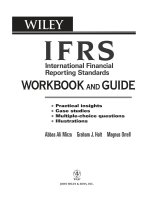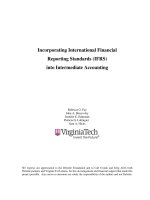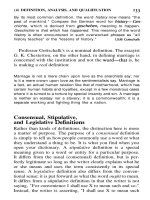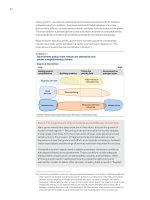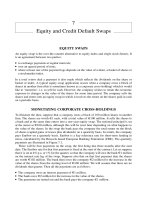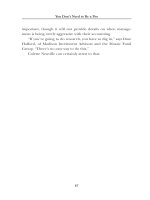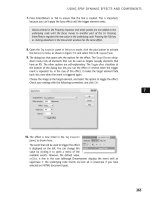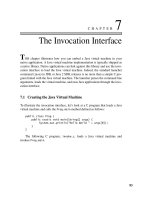INTERNATIONAL FINANCIAL REPORTING STANDARDS DESK REFERENCE Overview, Guide, and Dictionary phần 4 pot
Bạn đang xem bản rút gọn của tài liệu. Xem và tải ngay bản đầy đủ của tài liệu tại đây (145.81 KB, 39 trang )
EXCLUSIONS
• Leases for minerals, oil, natural gas, and similar regenerative resources
• Licensing agreements for films, videos, plays, copyrights, and similar
items
MAIN REQUIREMENTS
A lease is classified as a finance lease or an operating lease at its inception, that
is, when the agreement or commitment is made. A finance lease is one that trans-
fers substantially all risks and rewards incidental to ownership. All other leases
are regarded as operating leases. This classification is critical since it determines
the accounting treatment. The standard provides guidance as to what constitutes
the transfer of all risks and rewards. For example, all risks and rewards are re-
garded as being transferred if the agreement transfers legal title at the end of the
term or the lessee can purchase the asset at a price lower than the fair value at
the exercise date of that option. The standard does not specify rigid, numerical
thresholds to decide whether transfer has taken place. In the past, these thresh-
olds have been used by some entities to structure a lease to classify it in a way
that gives tax advantages or flatters their financial statements.
The lessee treats an operating lease as an expense on a straight-line basis
over the term of the lease. A finance lease is recognized as an asset and a lia-
bility in the lessee’s balance sheet at the lower of the fair value of the lease and
the present value of the minimum lease payments.
Finance lease payments should be apportioned between the finance charge
and the reduction of the outstanding liability. The finance charge represents a
constant periodic rate of interest on the outstanding liability. The leased asset
is depreciated in accordance with IAS 16. The same depreciation policy for all
assets should be applied to the asset held under the finance lease and, if there
is uncertainty over final ownership, the shorter of the lease term and the life
of the asset should be applied.
With regard to lessors, the operating lease assets should appear in the bal-
ance sheet according to the nature of the asset. Operating lease income will be
recognized over the lease term on a straight-line basis unless another basis is
more appropriate. With finance leases, the lease will be recorded in the bal-
ance sheet as a receivable at an amount equal to the net investment in the
lease. The finance income should be recognized on the basis of a constant pe-
riodic rate of return on the lessor’s net investment outstanding.
An entity may enter into a sale and leaseback transaction to improve its
liquidity by selling an asset to a third party. The arguments used, including
those by governments, are that their role is not to own and maintain property
102 • Guide to International Financial Reporting Standards
ccc_hussey_ias01_71-114.qxd 2/16/05 12:30 PM Page 102
but to concentrate on the main operational activities. The entity, having sold
the asset, leases it back from the third party and pays rental for its use. Such
transactions can be either finance or operating leases. In the case of the for-
mer, the entity must defer and amortize the excess of the sales’ proceeds over
the carrying amount for the period of the lease. With an operating lease, there
are four possible alternative transactions as follows:
If at fair value, the profit or loss is recognized immediately.
If sale price is below fair value, the profit or loss should be recognized
immediately, but if the loss is compensated by future rentals at below
market price, it should be amortized over the period of use.
If sale price is above fair value, the excess should be deferred and amor-
tized over the period of use.
If the fair value at the time of the transaction is less than the carrying
amount, the difference should be recognized immediately as a loss.
MAIN DISCLOSURE REQUIREMENTS FOR
FINANCE LEASES—LESSEE
• Carrying amount of asset
• Total minimum lease payments reconciled to their present value
• Details of minimum lease payments
• Description of significant leasing arrangements
MAIN DISCLOSURE REQUIREMENTS FOR
FINANCE LEASES—LESSOR
• Gross investment of the lease reconciled to the present value of the min-
imum lease payments
• Details of gross investment and present value of minimum lease pay-
ments
• Description of significant leasing arrangements
MAIN DISCLOSURE REQUIREMENTS FOR
OPERATING LEASES—LESSEE
• Details of minimum lease payments at balance sheet date under non-
cancelable leases
• Total of the future sublease income under non-cancelable leases
IAS 17 • 103
ccc_hussey_ias01_71-114.qxd 2/16/05 12:30 PM Page 103
• Lease and sublease payments recognized in income
• General description of significant leasing arrangements
MAIN DISCLOSURE REQUIREMENTS FOR
OPERATING LEASES—LESSOR
• Details of minimum lease payment amounts at balance sheet date under
non-cancelable operating leases
• General description of significant leasing arrangements
EXAMPLES OF RELATED NATIONAL STANDARDS
Australia: AASB 1008
Canada: CICA Handbook 3065
Malaysia: MASB 10
New Zealand: SSAP 18
Taiwan: SFAS 17
United Kingdom: SSAP 21
United States: SFAS 13
IAS 18
Revenue
ISSUED OR LAST REVISED
1993
EFFECTIVE DATE
Annual financial statements covering periods beginning on or after January 1,
1995.
104 • Guide to International Financial Reporting Standards
ccc_hussey_ias01_71-114.qxd 2/16/05 12:30 PM Page 104
PROBLEM AND PURPOSE
In some accounting regimes, revenue is referred to as sales or turnover but the
IASB uses the term revenue. The main issue in accounting for revenue is ascer-
taining the financial period when revenue is to be recognized. This is a far
more complex task than it would first appear. It is surprising how many enti-
ties still find that they have misstated revenue in their financial statements and
subsequently have to make adjustments. One assumes that these are honest
errors and not attempts to mislead. The appropriate allocation of revenue is
essential for calculating the correct profit figure for a financial period. IAS 18
defines revenue and identifies the two criteria for its recognition. First, it is
highly likely that future economic benefits will flow to the entity and, second,
that these benefits can be measured reliably. It defines the circumstances when
these two criteria are satisfied and provides guidance on the practical applica-
tion of the criteria.
SCOPE
Revenue arising from the sale of goods, the provision of services, and the use
of assets yielding interest, royalties and dividends.
EXCLUSIONS
Revenue specified in other standards, for example, revenue from lease agree-
ments under IAS 17.
MAIN REQUIREMENTS
Revenue is the gross inflow of economic benefits, for example, cash, receiv-
ables, and other assets arising from the ordinary operating activities of an en-
terprise. Revenue should be measured at the fair value of the consideration
that is received or receivable. There are instances where the inflow of cash or
cash equivalents is deferred, for example, when the seller provides interest-
free credit. In these cases, the fair value of the consideration that is receivable
is less than the nominal amount of cash and cash equivalents to be received,
and discounting is appropriate. It is critical to determine that a sale has taken
place. There have been many examples where a sale has been, in substance, a
financing arrangement and should be treated as such.
IAS 18 • 105
ccc_hussey_ias01_71-114.qxd 2/16/05 12:30 PM Page 105
Recognition from the sale of goods should only be recognized when:
• The seller has transferred to the buyer the significant risks and rewards
of ownership.
• The seller retains neither continuing managerial involvement to the de-
gree usually associated with ownership nor effective control over the
goods sold.
• The amount of revenue can be measured reliably.
• It is probable that the economic benefits associated with the transaction
will flow to the seller.
• The costs incurred or to be incurred in respect of the transaction can be
measured reliably.
Revenue from the provision of services should be recognized and the
percentage-of-completion method should be used when:
• The amount of revenue can be measured reliably.
• It is probable that the economic benefits will flow to the seller.
• The stage of completion at the balance sheet date can be measured reli-
ably.
• The costs incurred, or to be incurred, in respect of the transaction can be
measured reliably.
If these criteria cannot be met, a cost-recovery basis should be used with
revenue being recognized only to the extent that the recoverable expenses are
recognized. Revenue from interest, royalties, and dividends, assuming that
these are probable economic benefits that will flow to the entity and the
amount of revenue can be measured reliably, are recognized as follows:
• Revenue interest: on a time proportion basis that takes into account the
effective yield
• Royalties: on an accruals basis in accordance with the substance of the
relevant agreement
• Dividends: when the shareholders’ rights to receive payment are estab-
lished
The range of possible revenue transactions is extensive and complex. The
legal system in the country where the transaction takes place may set down
guidelines on when the revenue is recognized. In the absence of legal guidance
and if there is uncertainty on the timing of revenue recognition, it is essential
to determine the substance of the transaction. The following examples
demonstrate some of the variations:
106 • Guide to International Financial Reporting Standards
ccc_hussey_ias01_71-114.qxd 2/16/05 12:30 PM Page 106
• Goods are only accepted after inspection or installation. In this case the
revenue is normally recognized when the buyer formally accepts the
goods.
• Consignment sales where the initial buyer sells the goods on behalf of
the original supplier. Revenue is normally recognized when the goods
have been sold to a third party.
• Advertising commissions where the agency receives a commission for
placing advertisements or commercials. The revenue will only be recog-
nized when the advertisement or commercial is in the public domain.
• Real estate sales where the seller retains some form of involvement may
mean that revenue is not recognized but the transaction may be treated
as a joint venture or lease.
MAIN DISCLOSURE REQUIREMENTS
• Accounting policy
• Details of each specific classifications of revenue
EXAMPLES OF RELATED NATIONAL STANDARDS
Australia: AASB 1004
Canada: CICA Handbook 3400
Malaysia: MASB 9
Taiwan: SFAS 32
IAS 18 • 107
ccc_hussey_ias01_71-114.qxd 2/16/05 12:30 PM Page 107
IAS 19
Employee Benefits
ISSUED OR LAST REVISED
1998 and amended December 16, 2004
EFFECTIVE DATE
Annual financial statements covering periods beginning on or after January 1,
1999.
PROBLEM AND PURPOSE
Accounting for employee benefits raises a number of issues. The standard first
sets out recognition and measurement criteria for short-term employee bene-
fits such as compensated absence, profit-sharing, and bonus plans. The major
part of the standard is concerned with postemployment benefits and the ap-
propriate accounting treatment for defined contribution plans and defined
benefit plans. The appendices contain an illustrative example with disclo-
sures. In December 2004, the standard was amended to allow the additional
option of recognizing actuarial gains and losses in full in the period in which
they occur in a statement of recognized income and expense instead of in the
income statement. The original treatment of actuarial gains and losses being
recognized in the income statement in the period in which they occur or
spread over the service lives of the employees would remain.
SCOPE
Employee benefits are all forms of consideration given by an entity in ex-
change for services provided by employees in a financial period. These include
the following:
• Short-term benefits, for example, wages, salaries, and holiday pay
• Postemployment benefits, for example, pensions
108 • Guide to International Financial Reporting Standards
ccc_hussey_ias01_71-114.qxd 2/16/05 12:30 PM Page 108
• Other long-term benefits such as long-service leave and other benefits
not payable within 12 months
• Termination benefits, for example, redundancy pay
EXCLUSIONS
Employee benefits specified in other standards such as share-based payments
under IFRS 2 and employee benefit plans under IAS 26.
MAIN REQUIREMENTS
The guiding principle is that the cost of providing employee benefits should be
recognized in the period when the employee earns the benefit, rather than when
it is paid or payable. Short-term employee benefits are regarded as those payable
within 12 months after service is provided and should be recognized as an ex-
pense in the period that service is provided. In terms of non-accumulating com-
pensated absences, the expected cost of compensated absences is recognized
when the absences occur. In terms of accumulating compensated absences, the
cost is recognized when the service is provided, thus increasing the employee’s
entitlement to benefits. Profit-sharing and bonus payments should be recognized
when the entity has a legal or constructive obligation as a result of past events
and a reliable estimate of the expected cost can be made.
Postemployment plans are either defined contribution plans where the em-
ployer pays fixed contributions or defined benefit plans where the final benefit
is calculated according to certain criteria such as length of service and amount
of final salary. For defined contribution plans, contributions are recognized as
an expense in the period that the employee provides services. For defined ben-
efit plans, the amount recognized is the present value of the defined benefit
obligation at the balance sheet date. This is based on actuarial assumptions,
net of the fair value of any plan assets at the balance sheet date.
Other long-term employee benefits are recognized as a liability equal to the
present value of the defined benefit obligation minus the fair value of any plan
assets at the balance sheet date.
For termination benefits, the standard specifies that amounts payable
should be recognized when the enterprise is demonstrably committed to either:
• Terminating the employment of an employee or group of employees be-
fore their normal retirement date or
• Providing termination benefits as a result of an offer made in order to
encourage voluntary redundancy
IAS 19 • 109
ccc_hussey_ias01_71-114.qxd 2/16/05 12:30 PM Page 109
EXAMPLES OF RELATED NATIONAL STANDARDS
Australia: AASB 1028
Canada: CICA Handbook 3461
Malaysia: MASB 29
United Kingdom: FRS 17
United States: SFAS 87, SFAS 88, SFAS 106, SFAS 132
IAS 20
Accounting for Government
Grants and Disclosure of
Government Assistance
ISSUED OR LAST REVISED
April 1983
EFFECTIVE DATE
Annual financial statements covering periods beginning on or after January 1,
1984.
PROBLEM AND PURPOSE
Government grants and assistance do not have a major impact on most enti-
ties, but can have a significant effect on the financial statements where they
are present. This short standard sets out the accounting treatment and disclo-
sure requirements for government grants and the disclosure requirements for
other forms of government assistance.
110 • Guide to International Financial Reporting Standards
ccc_hussey_ias01_71-114.qxd 2/16/05 12:30 PM Page 110
SCOPE
All government grants and forms of government assistance.
EXCLUSIONS
• Government assistance in the form of benefits that are available in deter-
mining taxable income
• Government participation in the ownership of an entity
• Government grants covered by IAS 41
MAIN REQUIREMENTS
Government assistance consists of several types and has various conditions at-
tached to it. Some forms of assistance may be to induce an entity to take an
action it would not otherwise perform, for example, to open a new factory in
a specific economic area.
Government grants should not be credited directly to equity. Instead they
are recognized as income over the period so that they match with the related
costs for which they are intended to compensate. A systematic basis should be
used for this process. Grants cannot be recognized by an entity unless there is
reasonable assurance that:
• The entity will comply with the conditions attached to the grant.
• The grant will be received from the government.
A grant receivable as compensation for costs already incurred or for imme-
diate financial support, with no future related costs, should be recognized as
income in the period in which it is received.
If a grant becomes repayable, it should be treated as a change in account-
ing estimate under IAS 8. If the original grant relates to income, the repay-
ment should be applied first against any related unamortized deferred credit,
and any excess should be dealt with as an expense. If the original grant re-
lates to an asset, the repayment should be treated in the balance sheet either
as deferred income or as a deduction in determining the carrying amount of
the asset.
IAS 20 • 111
ccc_hussey_ias01_71-114.qxd 2/16/05 12:30 PM Page 111
MAIN DISCLOSURE REQUIREMENTS
• Accounting policy
• Nature and extent of grants
• Unfulfilled conditions and contingencies relating to recognized grants
EXAMPLES OF NATIONAL STANDARDS
Canada: CICA Handbook 3800
United Kingdom: SSAP 4
IAS 21
The Effects of Changes in Foreign
Exchange Rates
ISSUED OR LAST REVISED
December 2003
EFFECTIVE DATE
Financial statements covering periods beginning on or after January 1, 2005.
PROBLEM AND PURPOSE
The development of global business has resulted in many entities being in-
volved in various forms of relationships with other entities in different coun-
tries. These may include transactions conducted with foreign buyers or sellers,
or participation in foreign operations. In these circumstances, foreign curren-
cies are involved. Rules are required to ensure that these currencies are trans-
lated in a consistent manner.
The standard addresses the issue where an entity carries out transactions in
112 • Guide to International Financial Reporting Standards
ccc_hussey_ias01_71-114.qxd 2/16/05 12:30 PM Page 112
foreign currencies and/or has foreign financial operations. The transactions in
foreign currencies must be expressed in the entity’s reporting currency, and
the financial statements of foreign operations must be translated into the en-
tity’s reporting currency. The standard sets out guidance for the selection of
the exchange rate to be used and the recognition of the financial effects of
changes in exchange rates.
SCOPE
Accounting for foreign currency transactions and foreign operations in the fi-
nancial statements of an entity.
EXCLUSIONS
• Foreign currency derivatives (IAS 39)
• Hedge accounting of foreign currency items (IAS 39)
MAIN REQUIREMENTS
The general principle is that an entity should translate foreign currency items
and transactions into its functional currency. To do this translation, the spot
exchange rate between the functional currency and the foreign currency at the
date of the transactions is used. Average rates can be used, but care must be
exercised. If exchange rates fluctuate significantly over time or if there are a
small number of irregular transactions, the average can be distorted.
At each balance sheet date the following actions are taken:
• Use the closing rate to report foreign currency monetary items (such as
cash held, assets to be received, and liabilities to be paid in either fixed
amounts or amounts that can be determined).
• Use the exchange rate at the date of transaction to report non-monetary
items carried at historical cost.
• Use the exchange rate at the time when fair values were determined for
non-monetary items carried at fair value.
Exchange differences arise from translating the same monetary items at
different exchange rates. These differences normally occur due to the settle-
ment amounts payable or receivable in a foreign currency and the retransla-
tion during the preparation of financial statements at the period-end. The
monetary items that form part of the reporting entity’s net investment in a
IAS 21 • 113
ccc_hussey_ias01_71-114.qxd 2/16/05 12:30 PM Page 113
foreign operation are recognized as a separate component of equity in the fi-
nancial statements that include the foreign and the reporting equity. Such ex-
change differences are recognized in the income statement as profit or loss on
disposal of the net investment. All other differences are recognized in the in-
come statement for that period.
The results and financial position of a foreign operation are translated in the
reporting entity’s financial statements (the presentation currency) as follows:
• Assets and liabilities for each balance sheet presented (including com-
paratives) are translated at the closing rate at the date of that balance
sheet.
• Income and expenses for each income statement (including compara-
tives) are translated at exchange rates at the dates of the transactions.
• All resulting exchange differences are recognized as a separate compo-
nent of equity.
An entity whose functional currency is the currency of a hyperinflationary
economy should restate the financial statements as required by IAS 29.
MAIN DISCLOSURES
• Amount of exchange differences recognized in profit or loss
• Net exchange differences reconciled at the beginning and end of the pe-
riod and classified into separate components of equity
• Reasons if functional and presentational currencies are different
• Reasons for any change in functional currency for either the reporting
entity or the significant foreign operation
EXAMPLES OF RELATED NATIONAL STANDARDS
Australia: AASB 1012
Canada: CICA Handbook 1650
Malaysia: MASB 6
New Zealand: FRS 21
Taiwan: SFAS 14
United Kingdom: SSAP 20
United States: SFAS 52
114 • Guide to International Financial Reporting Standards
ccc_hussey_ias01_71-114.qxd 2/16/05 12:30 PM Page 114
IAS 23
Borrowing Costs
ISSUED OR LAST REVISED
December 1993
EFFECTIVE DATE
Financial statements covering periods beginning on or after January 1, 1995.
PROBLEM AND PURPOSE
In general, borrowing costs should be treated as an expense, but there are
circumstances where they can be capitalized. The effect of these different
treatments on the financial statements can be highly significant. Interest that
is expensed reduces the profit in that financial year. If the interest is capital-
ized, the income statement is not charged with the interest, and the asset in-
creases in value by the amount of the capitalized interest. This improves the
profit on the income statement and the leverage ratios. Without regulations
giving guidance on these two alternatives, an entity may select injudiciously,
and the financial statements could be misleading. The standard has expens-
ing as the benchmark treatment, but the allowed alternative treatment per-
mits capitalization subject to certain conditions. The standard gives guidance
on the amount of borrowing costs, directly attributable to the acquisition,
construction, and production of a qualifying asset that is eligible for capital-
ization.
SCOPE
• Interest on bank overdrafts and borrowings
• Amortization of discounts or premiums on borrowings
• Amortization of ancillary costs incurred in the arrangement of borrow-
ings
IAS 23 • 115
ccc_hussey_ias02_115-178.qxd 2/16/05 12:30 PM Page 115
• Finance charges on finance leases
• Exchange differences on foreign currency borrowings where they are re-
garded as an adjustment to interest costs
EXCLUSIONS
Actual or imputed cost of equity capital, including any preferred capital not
classified as a liability.
MAIN REQUIREMENTS
The benchmark treatment is expensing all borrowing costs in the period in
which they are incurred. The allowed alternative treatment permits borrow-
ing costs to be considered as part of the cost of the acquisition, construction,
and production of qualifying assets. These assets take up a substantial period
of time before they are ready for use. Examples include intangible assets that
are being developed and investment properties that are being constructed.
The treatment adopted must be applied consistently. The borrowing costs
that can be capitalized are not only loan interest but also other costs such as
interest on bank overdrafts, finance charges with respect to finance leases, and
amortization of ancillary costs incurred when borrowing is being negotiated
and arranged.
If the alternative treatment of capitalization is adopted, the following rules
apply:
• Costs eligible for capitalization are the actual costs incurred less any in-
come earned on the temporary investment of funds borrowed specifi-
cally.
• Where funds are part of a general pool, the capitalization rate is the
weighted average of the borrowing costs for the general pool.
• Capitalization commences when expenditures and borrowing costs are
being incurred and activities that are necessary to prepare the asset for
its intended use or sale are in progress.
• Capitalization ceases when substantially all of the activities are com-
plete.
• Capitalization must be suspended during periods where active develop-
ment is interrupted.
• Where construction is completed in stages, capitalization should cease
when substantially all of the necessary preparatory activities are com-
plete.
116 • Guide to International Financial Reporting Standards
ccc_hussey_ias02_115-178.qxd 2/16/05 12:30 PM Page 116
ILLUSTRATIVE EXAMPLE: BORROWINGS CAPITALIZED BY THE
WEIGHTED AVERAGE COST OF THE CAPITAL METHOD
An entity has the following general loans:
$2 million @ 5%
$1 million @ 6%
$500,000 @ 8%
It intends to extend its production line at a cost of $600,000. The project
will take 3 months from start to completion.
Weighted average calculation is:
($2 million @ 5% + $1 million @ 6% + $500,000 @ 8%)/$3.5 million
= $100,000 + $60,000 + $40,000 / $3.5 million
= 5.714%
Borrowing costs to be capitalized
= $600,000 (cost of asset) × 5.714% × 0.25 year
= $8,571
MAIN DISCLOSURES
• Accounting policy applied to material borrowing costs incurred
• Accounting policy and the amount of borrowing costs capitalized and
the capitalization rate
EXAMPLES OF RELATED NATIONAL STANDARDS
Australia: AASB 1036
Canada: CICA Handbook 3850
Malaysia: MASB 27
Taiwan: SFAS 3
United States: SFAS 34
IAS 23 • 117
ccc_hussey_ias02_115-178.qxd 2/16/05 12:30 PM Page 117
IAS 24
Related Party Disclosures
ISSUED OR LAST REVISED
December 2003
EFFECTIVE DATE
Financial statements covering periods beginning on or after January 1, 2005.
PROBLEM AND PURPOSE
Normal features of business transactions involve interrelationships and trad-
ing connections among different entities. These often have no effect on nor-
mal day-to-day operations, but some transactions are conducted between
related parties. This is regarded as the situation where one party has the abil-
ity to control the other party or exercise significant influence over the other
when making financial and operating decisions. Such control and influence
may not be applied to all or any transactions. Where such control or influence
is exercised, it may have an effect on the financial position and operating re-
sults of the reporting entity. The user of the financial statements needs to be
aware of this possibility to properly understand the financial statements. This
short standard describes examples of relationships where disclosures may be
required and the nature of the disclosures.
SCOPE
• Where one party has the ability to control the other party, exercise sig-
nificant influence, or exercise joint control over the other party when
making financial and operating decisions.
• Where a transfer of resources, services, or obligations between related
parties (regardless of whether a price is charged) takes place.
118 • Guide to International Financial Reporting Standards
ccc_hussey_ias02_115-178.qxd 2/16/05 12:30 PM Page 118
EXCLUSIONS
• Two enterprises where they simply have a director or key manager in
common
• Two venturers who share joint control over a joint venture
• Providers of finance, trade unions, public utilities, government depart-
ments, and agencies in the course of their normal dealings with an enter-
prise
• Economic dependency through a single customer, supplier, franchiser,
distributor, or general agent with whom an enterprise transacts a signifi-
cant volume of business
MAIN REQUIREMENTS
The standard specifies several circumstances where one party is related to an-
other if:
• Directly or indirectly, through one or more intermediaries, the party
controls or is controlled by, or is under common control with, the entity
(this includes parents, subsidiaries and fellow subsidiaries).
• One party has an interest in the entity that gives it significant influence.
• One party has joint control over the entity.
• It is an associate of the entity.
• It is a joint venture whereby the entity is a venturer.
• It is a close member of key management personnel of the entity or its
parent. The presence of close family members in circumstances where
control or significant voting power occurs is deemed to give rise to a re-
lated party relationship.
• It is a postemployment benefit plan for the benefit of employees of the
entity, or of any of its related parties.
MAIN DISCLOSURES
• The name of its parent and, if different, the ultimate controlling party,
irrespective of whether transactions have taken place. If neither the en-
tity’s parent nor the ultimate controlling party produces financial state-
ments available for public use, the name of the next most senior parent
that does so must also be disclosed.
• Compensation of key management personnel who have authority and
responsibility for planning, directing, and controlling the activities of the
IAS 24 • 119
ccc_hussey_ias02_115-178.qxd 2/16/05 12:30 PM Page 119
entity, directly or indirectly, including all directors (whether executive or
otherwise).
• Details of transactions among related parties and a statement that the
related party transactions were made on terms equivalent to those that
prevail in arm’s length transactions. This statement should be made only
if it can be substantiated.
EXAMPLES OF RELATED NATIONAL STANDARDS
Australia: AASB 1017
Canada: CICA Handbook 3840
Germany: GAS 11
Malaysia: MASB 8
New Zealand: SSAP 22
Taiwan: SFAS 6
United Kingdom: FRS 8
United States: SFAS 57
IAS 26
Accounting and Reporting by
Retirement Benefit Plans
ISSUED OR LAST REVISED
January 1987
EFFECTIVE DATE
Financial statements covering periods beginning on or after January 1, 1988.
120 • Guide to International Financial Reporting Standards
ccc_hussey_ias02_115-178.qxd 2/16/05 12:30 PM Page 120
PROBLEM AND PURPOSE
Retirement benefit plans are a common feature of business. They are arrange-
ments by which an entity provides benefits for employees on or after termina-
tion of service when such benefits, or the contributions toward them, can be
determined or estimated in advance of retirement from the provisions of a
document or from the entity’s practices. Retirement benefit plans may be re-
quired, by regulation or some form of agreement, to make a report to all par-
ticipants in the plan. The standard applies when such reports are required and
it should be read in conjunction with IAS 19.
SCOPE
Applies to the financial statements of retirement benefit plans.
MAIN REQUIREMENTS
The standard distinguishes between defined contribution plans and defined
benefit plans. Defined contribution plans are those in which payments or con-
tributions into the plan are fixed. The benefits paid to retired members will
depend on the value of the investments made from the contributions and the
investment returns that are reinvested. Defined benefit plans are those in
which the benefits received by a retired member are fixed. Contributions paid
into the plan are based on an estimate of the future payments from the plan.
The objective of a defined contribution plan disclosure is to provide infor-
mation about the conduct of the plan and the performance of the investment.
The financial statements of a defined contribution plan contain a statement of
net assets available for benefits and a description of the funding policy. The
objective of a defined benefit plan disclosure is to provide information about
the balance between the future obligations under the plan and the resources it
has available to meet these obligations. The financial statements contain one
of the following:
• A statement that shows the net assets available for benefits, the actuarial
present value of promised retirement benefits distinguishing between
vested and non-vested benefits, and the resulting excess or deficit or
• A statement of net assets available for benefits with a note disclosing the
actuarial present value of promised retirement benefits, distinguishing
between vested and non-vested benefits, or a reference to this informa-
tion in an accompanying actuarial report.
IAS 26 • 121
ccc_hussey_ias02_115-178.qxd 2/16/05 12:30 PM Page 121
MAIN DISCLOSURES
• Accounting policies
• Details of net assets available for benefit
• Details of changes in net assets available for benefit
• Description of funding policy of the plan
EXAMPLES OF RELATED NATIONAL STANDARDS
Canada: CICA Handbook 3461
Malaysia: MASB 30
New Zealand: FRS 32
United Kingdom: SSAP 24
United States: SFAS 81
IAS 27
Consolidated and Separate
Financial Statements
ISSUED OR LAST REVISED
December 2003
EFFECTIVE DATE
Financial statements covering periods beginning on or after January 1, 2005.
PROBLEM AND PURPOSE
Investors need to be informed of the combined financial position and perfor-
mance of all the individual companies in a group in order to make an in-
122 • Guide to International Financial Reporting Standards
ccc_hussey_ias02_115-178.qxd 2/16/05 12:30 PM Page 122
formed assessment. A parent company, with some exceptions, should present
consolidated financial statements. The standard gives guidance on the consol-
idation procedures, accounting for investment subsidiaries, and the disclo-
sures required.
SCOPE
• The preparation and presentation of consolidated financial statement
for a group of entities under the control of a parent.
• Accounting for investments in subsidiaries, jointly controlled entities,
and associates in the separate financial statements of a parent.
EXCLUSIONS
A parent need not present consolidated financial statements if the following
four conditions are met:
The parent is itself a wholly-owned subsidiary, or is a partially owned
subsidiary of another entity and its other owners, including those not
otherwise entitled to vote, have been informed about, and do not object
to, the parent not presenting consolidated financial statements.
The parent’s debt or equity instruments are not traded in a public market.
The parent did not file, nor is it in the process of filing, its financial
statements with a securities commission or other regulatory organiza-
tion for the purpose of issuing any class of instruments in a public
market.
The ultimate parent or any intermediate parent of the ultimate parent
that produces consolidated financial statements available for public use
that comply with International Financial Reporting Standards.
MAIN REQUIREMENTS
Consolidated accounts should include all of the parent’s subsidiaries, both do-
mestic and foreign, except where control is intended to be temporary because
the subsidiary is acquired and held exclusively with a view to its subsequent
disposal in the near future. A subsidiary is one enterprise controlled by an-
other. The standard concentrates on the substance of the relationship between
two entities to determine whether consolidated financial statements are re-
IAS 27 • 123
ccc_hussey_ias02_115-178.qxd 2/16/05 12:30 PM Page 123
quired. There is the presumption that one entity is controlled by another if the
investor has more than 50% of the voting rights. However, it is necessary to
examine the substance and not rely solely on the numerical threshold. Con-
trol can be evidenced by the presence of power, for example, where the parent
entity has the ability to appoint or remove the majority of the members of the
board of the controlled entity.
Special purpose entities (SPEs) should be consolidated where the substance
of the relationship indicates that the SPE is controlled by the reporting enter-
prise. This may arise even where the activities of the SPE are predetermined or
where the majority of voting or equity is not held by the reporting enterprise.
For example, an SPE may be created where there are explicit limits restricting
the decision-making powers of the governing body. The SPE may have been
created to achieve a well-defined aim, and as such the operations are predeter-
mined with little need for changes in operational decisions. In this case, the
sponsor will have a significant beneficial interest in the SPE’s activities, and
the financial statements should be consolidated.
Subsidiaries are not required to be consolidated where they have been ac-
quired and held with the sole intention of subsequent disposal in the near fu-
ture. In these cases, the subsidiaries will be accounted for under the provisions
of IAS 39.
The financial statements of the parent and its subsidiaries must be prepared
using uniform accounting policies for like transactions and other events in
similar circumstances with the reporting dates being no more than three
months apart.
In the parent’s/investor’s individual financial statements, investments in
subsidiaries, associates, and jointly controlled entities should be accounted
for, either at cost or conforming to IAS 39. These investments should not
be accounted for by the equity method in the parent’s/investor’s separate
statements.
MAIN DISCLOSURES
• The fact that subsidiaries are not consolidated, and, thus, summarized
financial information of such subsidiaries should be disclosed either in-
dividually or in groups.
• The nature of the relationship between the parent and a subsidiary when
the parent does not own, directly or indirectly through subsidiaries,
more than half of the voting power.
• The reasons why the ownership, directly or indirectly through sub-
sidiaries, of more than half of the voting or potential voting power of an
investee does not constitute control.
124 • Guide to International Financial Reporting Standards
ccc_hussey_ias02_115-178.qxd 2/16/05 12:30 PM Page 124
EXAMPLES OF RELATED NATIONAL STANDARDS
Australia: AASB 1024
Canada: CICA Handbook 1600
Germany: GAS 4
Malaysia: MASB 11
New Zealand: FRS 36
Taiwan: SFAS 7
United Kingdom: FRS 6
United States: SFAS 141
IAS 28
Investment in Associates
ISSUED OR LAST REVISED
December 2003
EFFECTIVE DATE
Financial statements covering periods beginning on or after January 1, 2005.
PROBLEM AND PURPOSE
An investor may have a significant influence in an entity that is neither a sub-
sidiary nor a joint venture, so that it does not appear in the consolidated fi-
nancial statements under the provisions of IAS 27. It is important that the
user be made aware of the nature and implications of this investment. The
standard sets out the criteria to establish significant influence and provides
guidance on accounting for associates in the consolidated financial statements
under the equity method and the disclosures required. Generally, significant
IAS 28 • 125
ccc_hussey_ias02_115-178.qxd 2/16/05 12:30 PM Page 125
influence is considered as one entity having the power to participate in the fi-
nancial and operating policies of another entity but without having control or
joint control over these policies.
SCOPE
All investments where investors have significant influence but do not have
control or joint control.
EXCLUSIONS
Investments held by venture capital organizations or mutual funds, unit
trusts, and similar organizations and are:
• Designated at fair value on recognition through the income statement;
or
• Held for trading and accounted for under IAS 39.
MAIN REQUIREMENTS
The presence of significant influence in an entity normally arises where the in-
vestor has 20% or more of the voting power. There are exceptions to this
rule. For example, an investor may hold more than 20% of the voting rights,
but is unable to exercise significant influence because another investor holds
the remaining voting rights. The reverse situation can occur where the in-
vestor has less than 20% of the voting rights, but circumstances permit signif-
icant influence to be applied.
Where there is significant influence, the equity method of accounting for
investments in associates should be used in the consolidated financial state-
ments. Under the equity method, an equity investment is initially recorded at
cost and is subsequently adjusted to reflect the investor’s share of the net
profit or loss of the associate. Examples of the key exceptions to the equity
method include the following:
• When an investment is held for sale and, therefore, falls under IFRS 5.
• When an investor is itself a subsidiary and its other owners have been
informed that the equity method is not being used and they do not ob-
ject.
126 • Guide to International Financial Reporting Standards
ccc_hussey_ias02_115-178.qxd 2/16/05 12:30 PM Page 126
